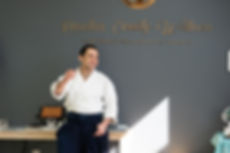
More Than Just Technique
Aikido is a traditional Japanese martial art developed by Morihei Ueshiba in the early 20th century. Respectfully given the name O'Sensei, or Great Teacher, by his students, Aikido is a physical practice of philosophical principles striving for the ultimate goal of peaceful resolution, rather than defeat.
Proper etiquette, attitude, and behavior are the cornerstones and hallmarks of most martial arts, and aikido is no exception.
Aikidoka here in Tarpon Springs, Tampa Bay, Florida, train to harmonize with, rather than confront an aggressive line of force, converting it into a circular motion that renders attackers helpless. Aikidoka learn to apply thousands of variations of wrist locks, arm pins, and unbalancing throws to subdue and neutralize attackers without serious injury. These practices are coupled with learning the Aikido art of falling, or "ukemi", which trains the body and mind to receive such techniques in a safe manner.
805 Live Oak St, Tarpon Springs, Florida
Tampa Bay's #1 Traditional Martial Arts

ABOUT THE FOUNDER
Morihei Ueshiba (植芝 盛平, Ueshiba Morihei, December 14, 1883 – April 26, 1969) was a Japanese martial artist and founder of the martial art of aikido. He is often referred to as "the founder" Kaiso (開祖) or Ōsensei (大先生/翁先生), "Great Teacher".
The son of a landowner from Tanabe, Ueshiba studied a number of martial arts in his youth, and served in the Japanese Army during the Russo-Japanese War. After being discharged in 1907, he moved to Hokkaidō as the head of a pioneer settlement; here he met and studied with Takeda Sōkaku, the founder of Daitō-ryū Aiki-jūjutsu. On leaving Hokkaido in 1919, Ueshiba joined the Ōmoto-kyō movement, a Shinto sect, in Ayabe, where he served as a martial arts instructor and opened his first dojo. He accompanied the head of the Ōmoto-kyō group, Onisaburo Deguchi, on an expedition to Mongolia in 1924, where they were captured by Chinese troops and returned to Japan. The following year, he had a profound spiritual experience, stating that, "a golden spirit sprang up from the ground, veiled my body, and changed my body into a golden one." After this experience, his martial arts skill appeared to be greatly increased.
Ueshiba moved to Tokyo in 1926, where he set up the Aikikai Hombu Dojo. By now he was comparatively famous in martial arts circles, and taught at this dojo and others around Japan, including in several military academies. In the aftermath of World War II the Hombu dojo was temporarily closed, but Ueshiba had by this point left Tokyo and retired to Iwama, and he continued training at the dojo he had set up there. From the end of the war until the 1960s, he worked to promote aikido throughout Japan and abroad. He died from liver cancer in 1969.
After Ueshiba's death, aikido continued to be promulgated by his students (many of whom became noted martial artists in their own right). It is now practiced around the world.


OUR LINEAGE
Our dojo is proud to have been originally sponsored by Aikido Schools of New Jersey Founder, Richard Stickles Sensei, 7th Dan Shihan.
Stickles Sensei began his training at New York Aikikai under Yoshimitsu Yamada Sensei, 8th Dan Shihan, spending years as Soto Deshi and Otomo and opened Aikido Schools of New Jersey in 1977.
Yoshimitsu Yamada Sensei began his training under O'Sensei, spending years as an Uchi Deshi before traveling to the United States to help in the spread of Aikido worldwide.
Our Chief Instructor, Reuven Lirov began his training under Stickles Sensei in 2007, followed by his 2 years as Uchi Deshi. Following Stickles Sensei's passing, Peter Bernath Sensei took over sponsorship of Pinellas County Aikikai.


COOPERATIVE TRAINING
Aikido is not a sport and so there are no competitive tournaments. Instead, Aikidoka here in Tarpon Springs, Tampa Bay, Florida, learn to better themselves without belittling others, without harmful intent or fear of injury. As a traditional budo, Aikido maintains the quality of martial spirit, effective technique, and intense training. Coupled with mutual respect and caring, this encourages O'Sensei's desire for universal peace through the practice of Aikido.

DIVERSITY, DEBATE, INCLUSION
Our dojo is an extended family of sorts by definition. We strive together to improve our technique, which in turn focuses our minds, as the blade is sharpened by the stone.
Naturally, families bring with them their core beliefs, values, and desires, which may at times, be at odds (not only between individuals, but even within oneself).
The dojo is meant to be a place where we can explore all aspects of our personal development in an honest and open way. Know that while we will not prevent anyone from speaking freely and exercising their 1st amendment rights - we will however, do our best to promote the Sokratic method of debate, focused on first, establishing common ground - and most importantly - that we are all one dojo family, one American family - on a journey together, however we disagree on the route best to take.
